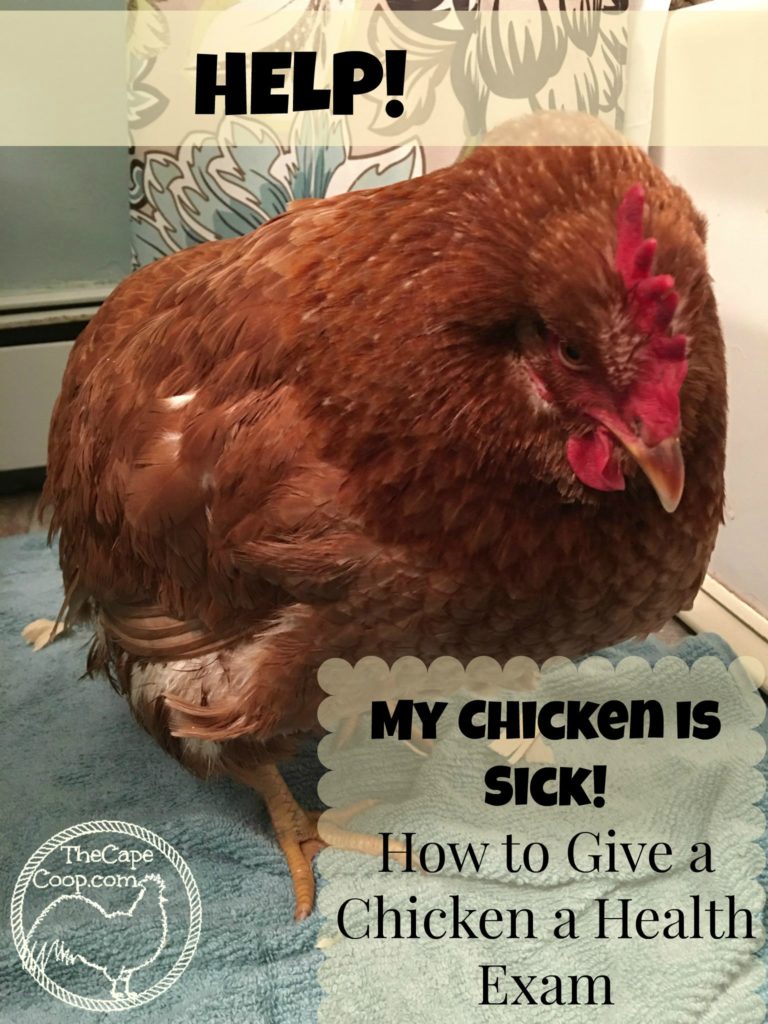---------------------------------------------------------
Disclaimer: I am NOT a veterinarian, just an animal owner & lover sharing my opinions and experiences. Any advice on caring for animals or diagnosing & treating medical conditions for animals should be evaluated by a trained veterinarian. Whenever possible, you should always have your sick or injured bird evaluated & treated by a trained professional.
Eventually, it will happen to every chicken owner. You will go out to the chicken coop in the morning and notice someone isn’t coming out of the coop, or maybe they come out, but just stand quietly in the corner while everyone else is pecking around.
Some diagnoses are easy – if your chicken is limping you would look for a leg or foot problem. Most times the clues that your chicken is sick will be very subtle. Chickens are the ultimate prey animal. Everyone loves a good chicken dinner! Because of this, over past several thousand years chickens have become excellent at hiding weakness (did you know chickens have been domesticated for at least 5,000 years, and possibly up to 8,000 years?). As a chicken owner you should spend a little time every day observing their behaviors so you can catch any changes early.
This isn’t an all inclusive of everything that can go wrong with a chicken, but will cover many of the most common ailments. What should you do when you find something amiss? Grab your chicken first aid kit and we’ll try to get to the bottom of this (want to check out what is in my first aid kit? click here to read about it)

Isolate any chicken you suspect is ill
Step one is always to remove the sick chicken from the flock until you figure out what is going on. You don’t want the rest of the flock being exposed. Isolation will also make her easier to treat. Isolating a chicken means they are kept at least 30-40 feet from the rest of the flock. Make sure the isolated chicken has a secure coop, safe from predators with access to fresh food, water, & grit. Click here to see the hospital coop I made from recycled materials
Check out her comb & wattles
Dehydration can cause a normally erect comb to flop over. Make sure she has access to plenty of fresh cool water. If it is warm out, a pale comb could indicate heat exhaustion. Try filling a shallow pan with cold water and stand the chicken in it (don’t submerge her, it could be too great a shock). Give her plenty of fresh, cool water and offer some chilled watermelon as a snack.
A pale pink comb
A normal, healthy chicken should have a bright red comb. If the comb is a pale pink it could be a sign of anemia. Anemia can be caused by a parasite infestation like mites, lice, worms. To check for external parasites like mites and lice, part the feathers in several places and look carefully at the chicken’s skin for tiny creepy crawlies.
Mites look like tiny, almost translucent red fleas and can often be found under their wings. Lice look like very tiny grains of rice and they lay their eggs at the feather shafts. Both can often be seen near the chicken’s vent. Other common side effects of external parasites include feather picking or bald spots, dirty looking or dull feathers, lethargy and loss of appetite. Click here to read more about mites & lice. If one chicken has external parasites, it’s a good bet the whole flock has them. Totally empty and clean the coop, sprinkle food grade Diatomaceous Earth in all the corners before refilling with shavings. Dust the chickens with DE or treat them with topical medications like Ivomec Eprinex or Elector PSP.
A pale comb could also indicate internal parasites (worms). Common side effects of worms include very loose, watery droppings (sometimes the worms or worm casings can be seen in the droppings). The chicken might also have an increase in appetite but with weight loss. Just like with internal parasites, if one chicken has worms, you should worm the entire flock & disinfect their coop. There are several different kind of worms chickens can get and unfortunately there is not an all inclusive wormer available. A fecal test by your vet (or an at home pet fecal test kit) can help identify the type of worms your flock has and recommend the appropriate treatment. click here to read more about worms & chickens
Molting can also cause a pale comb. If there are feathers everywhere that is likely the cause. Click here to read more about molting
Spots on the comb
Ashy looking black or brown spots on the comb/wattle/any unfeathered skin can indicate fowl pox. One or two spots is not a cause for concern and is probably a scab from another chicken pecking them. Fowl pox would be accompanied by lethargy, loss of appetite, nasal discharge, and weight loss. The less common form of Fowl Pox is “wet” pox which is when the lesions form inside the GI and respiratory tract. Wet pox can block breathing & eating and have the added symptom of “wet” sounding breathing.
Similar to chicken pox in humans it is very contagious (to other chickens) and there isn’t much you can do to “cure” it as it is a viral infection. You can just treat the symptoms & try to contain the spread in your flock. Boost their immune systems with vitamins and electrolytes to help their body fight the virus, and keep any infected birds separate.
A purple/blue comb
A purple or bluish comb usually indicates a respiratory problem, circulatory problem, or lack of oxygen in her blood. Circulatory problems can be signs of a heart failure or stroke. Unfortunately if your chicken suffers a heart attack it is unlikely to survive. They will often be found lying on their back, unresponsive. Leading up to the heart attack you might notice the purple comb or signs of water belly (fluid build up in their abdomen). Click here to read more about water belly. For more about respiratory issues, keep reading below.
Listen to her breathing
Hold the chicken close to your ear and put your hands on either side of her to feel her breathing. Listen closely. Is she gasping for air? Does her breathing sound gurgly or raspy?
Gasping or making a choking motion could indicate gape worm, a worm that takes up residence in your chicken’s trachea. Other symptoms would include coughing and shaking their head. If you check the throat, you can sometimes see the red worms attached to the trachea. If gape worm is suspected, it’s best to worm the flock with an appropriate wormer.
Another reason for gasping is there is something stuck in her throat. Carefully open her beak and look into her throat (if you have a helper this will be much easier).
If your chicken has raspy breathing, sneezing, runny nostrils, and/or foamy eyes she could have a respiratory illness. This can also sometimes be accompanied by lethargy or loss of appetite. Basically a common cold for chickens, you should keep her separate until symptoms go away. Boost her immune system with vitamins & electrolytes. I also like to use VetRx, you can put it near their nostrils or under their wing. It is kind of like a menthol rub when you are feeling congested. If symptoms are not easing within a week, antibiotics might be needed.

Check her droppings
Sometimes it can be hard in a large flock to tell which chicken is leaving the funky droppings you just found. If it’s very watery, it can be easy to tell because the offender will usually have dirty bum feathers. Otherwise, you are left just standing around watching chickens poop until you see who is leaving behind the offensive ones. This is another reason why separating the ill chicken is helpful. You can diagnosis a lot of illnesses through their poop.
Anytime you take your chicken to the vet for an illness, it’s handy to bring along a fecal sample for testing. There is a huge range of normal looking poops and plenty of non normal ones. If you have the stomach for it, The-Chicken-Chick.com has the most informative post on chicken droppings I have seen, complete with pictures. You can check that out here.
I will spare you the photo, but Abigail’s poop is pretty runny. Coupled with her strained breathing and the hunched over stance, I want to check in her vent for egg binding
Check her vent
Egg Binding
Egg binding can happen when an egg gets stuck in the oviduct. It happens most often in young layers, but it can happen at any time in a chicken’s egg laying career. Abigail is an older girl, she’s 4 and only lays a couple of times a week, sometimes not even that often, but better safe than sorry. An egg bound hen will be lethargic with her tail down. Perhaps looking like she is straining and waddling with a penguin like stance. She will also have loss of appetite, a pale comb, and she will either have loose stools or none at all.
This is a very serious condition and if she does not pass the egg within 2 days she could die. If you suspect this, handle the hen carefully to avoid breaking the egg inside of her. This could lead to a fatal infection. Carefully bring her inside where you have bright light and a clean work space. Apply a generous amount of Vaseline to a gloved finger and carefully insert it into her vent. If the egg is in there it will be close to the vent. The egg will be within the first inch or two, if it’s not there she is not egg bound.
If you do feel an egg, fill a tub with a few inches of warm water with added Epsom salt. Seat the chicken in the water for about 15-20 minutes while massaging her abdomen. You can apply more Vaseline around her vent and near the egg. Often this will ease the egg out. If it doesn’t, take her out and wrap her in a warm towel. Crush a calcium rich Tums antacid tablet and feed it to her. Put the hen in a warm, dark place (a dog crate with a blanket over it would be perfect). The combination of the extra calcium and the warmth & dark hopefully will encourage her to lay. If not, an emergency visit to the vet is in order so they can extract the egg.

Check her feet
Inspect her feet and legs. Are there any obvious cuts or injuries? If so, thoroughly clean the wound with Vetericyn and wrap it to keep clean.
Scaly Leg Mites
Do her lower legs look thickened, scabby & crusty? This can be a sign of scaly leg mites. These parasites burrow under the leg scales to snack on tissue. It can be painful and chickens with severe infestations might be limping. If the infestation is not too severe you can try this natural remedy – soak the chicken’s legs in warm water with Epsom salt for about 20 minutes. Rub the scales to loosen the scabs. Next, dip her feet & legs in oil (most oils will be fine, vegetable oil is a good choice as it’s fairly cheap). Let her sit in the oil for about 5 minutes to suffocate the mites. Dry her off and slather Vaseline on her legs. You should repeat this process a couple of times a week until her legs look healthy again. For severe infestations, your vet can prescribe an anti parasitic medication.
Bumblefoot
The other issue you should check for on your chicken’s feet is bumblefoot. Bumblefoot is an infection on the underside of their foot. It is fairly common, a chicken gets a cut on her foot and then is walking around in dirt and poop, you can see how that could easily lead to infection. In it’s early stages, it will look like a black or brown scab on the bottom of the foot. This may sometimes be accompanied by redness or swelling. The chicken might be limping or sitting a lot to stay off her feet. She may have lost interest in eating because it’s painful to stand. You want to catch this in it’s early stages, as the infection advances it can get in their bloodstream and lead to death. The infection forms a pus filled abscess on the foot (under the black scab).
The first step in treating this is to remove the abscess. Assemble Epson salt, Vetericyn spray, Vetrap bandages & gauze pads, gloves, and antibiotic ointment. Soak the chicken’s feet in warm water with Epson salt for about 10 minutes to loosen the tissue. Use gloves to prevent spreading the infection between the two of you.
Spray the area liberally with Vetericyn, wiggle the black scabbed abscess. In early stages the abscess will only be lightly attached and you should be able to wiggle and pull the infection kernel out. Deeper abscesses will be more firmly attached and will require surgical removal. If you feel confident with the scalpel, you can cut it out (there are dozens of videos on how to do this on youtube). If not, it’s best to consult with a vet.
In either event, once the abscess is out, it will bleed. Slather the area with an antibiotic ointment, cover with a clean gauze pad, and wrap with Vetrap. Change the bandages daily, reapplying Vetricyn & antibiotic ointment for about a week or until the area is healed.
Luckily I was able to wiggle out the abscess from Abigail’s foot. She actually had one on each foot, both about 1/2 inch deep. I’m sure this was painful for her to walk on, and having an infection can cause lethargy and lack of appetite. Surprisingly she was not limping at all, this just goes to show you how well chickens can mask pain. Not eating and drinking enough was leading to runny stools. She is comfortably recovering in the hospital coop, and getting electrolytes and plenty of mealworm treats 🙂 Now if she would just leave her bandages alone…..










Aaron
Monday 29th of May 2023
My rooster isn't eating and his tail feathers are looking a little ruff and he isn't crowing like normal it short and very quiet.
Liz
Monday 29th of May 2023
Unfortunately that can be several things - I would start by inspecting him for external parasites (lice) and inspect his dropping for signs of internal parasites (worms). Parasites can often be the cause of lack of energy and general depressed mood. It can also effect their feathers & appearance. Good luck!
Heather Bennett
Thursday 2nd of June 2022
I have a 2-21/2 month old chick that is constipated. She currently has a string of grass and poop hanging out of her vent. I have soaked her in warm epson salt water. Anything else I can do for her?
Liz
Monday 6th of June 2022
If she has a long strand of grass hanging from the vent that would signal some sort of issue with her digestive system. You can also try restoring her gut balance by giving her some warm water with dissolved epson salt. Does she have grit? Grit (small stones, sand) is necessary for chickens to grind food because they have no teeth
wali
Monday 4th of April 2022
hi dear liz I am in Afghanistan our life is very bad situation I have a small 45 eggs incubator so I need your help to how I can control chicken disease if you want to help me my WhatsApp number is 0093704079201 that will be your kind
Liz
Tuesday 5th of April 2022
I don't have WhatsApp but if you'd like to email me, you can at liz@thecapecoop.com
Emasoft
Thursday 9th of September 2021
I have one hen it has a balloon like neck and it has a swollen crop.The crop where food is stored is very big it looks like the crop has been pumped...the crop is like a balloon when you touch it and it also makes the snore sound but it walks normally and it seems everything is okay. what could be the possible disease and treatment
Liz
Thursday 9th of September 2021
It sounds like your hen has sour crop, it is a yeast infection in the crop causing the food in the crop to ferment. The fermenting food can cause a smelly liquid to leak out of her mouth, which is the other major symptom of sour crop. There is a great set of instruction that I keep bookmarked, which you should find very helpful in treating her. You can find it here: https://www.chickensandmore.com/sour-crop/ Good luck!
Lily
Tuesday 27th of April 2021
Hello, I have a older chicken who seems to be sick she is 5 years old, we just got 4 new chicks who are now about a year old and a other chicken who is the same age as the chicken who seems to be sick, the sick chicken or ¨blue¨ is at the bottom of the pecking order and is very nervous and not as freindly as our other birds, she hasent laid eggs in a long time and idk if that is because of stress, lack of food/water or old age. She diddent come out of the coop this morning but now is out side but just laying down, she is kinda flexing and almost gulping her back like she is trying to get a egg/poop out. what should I do?
Liz
Tuesday 27th of April 2021
It's really hard to say - it could be any of the things you mentioned. If you see that her vent is straining and she is waddling/walking strange I would check to see if she is egg bound. If you find there is an egg stuck, put her in a warm, dark place and feed her some crushed up tums. You can also try sitting her in a shallow tub of warm water to try an encourage the egg to come out